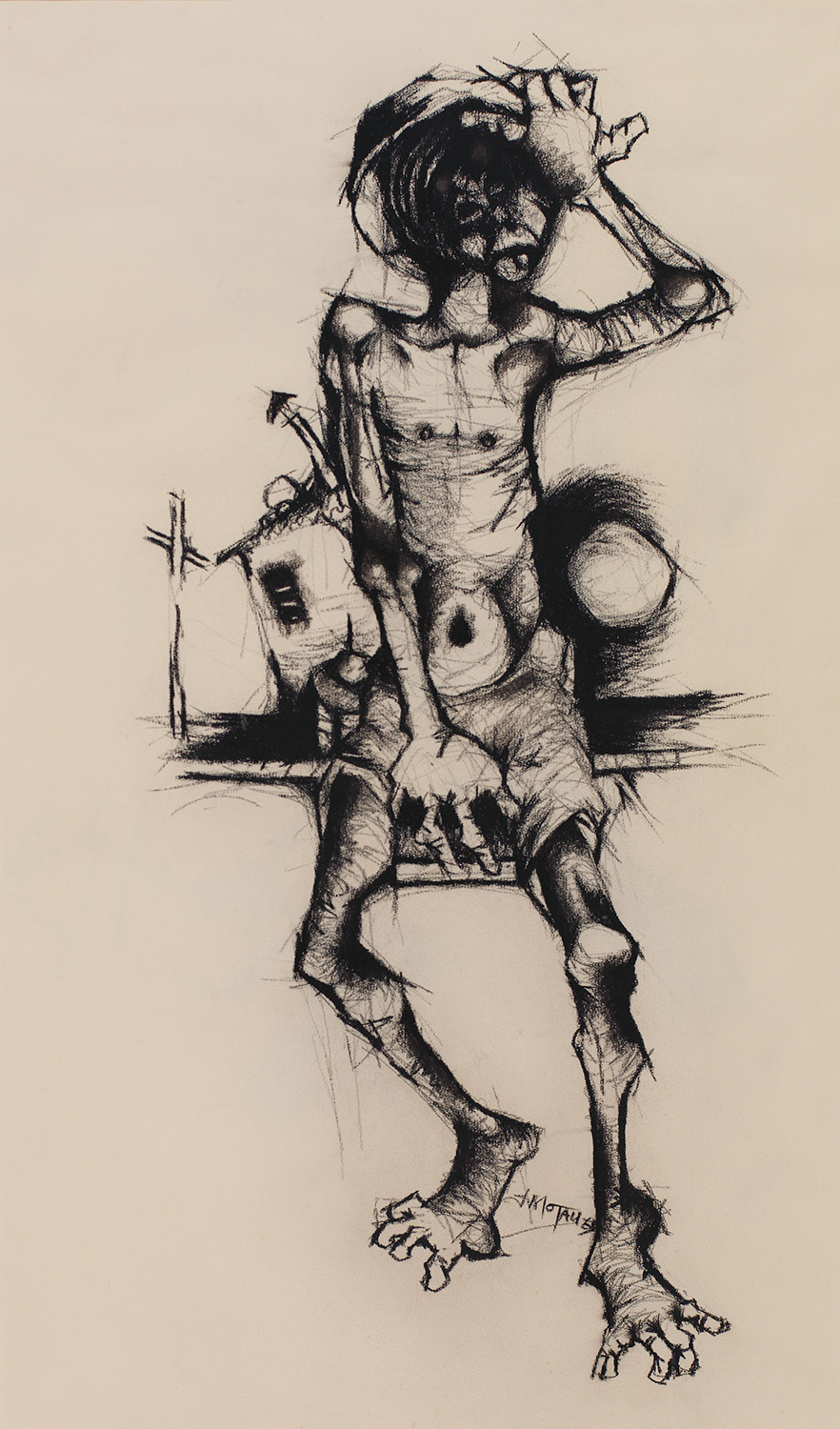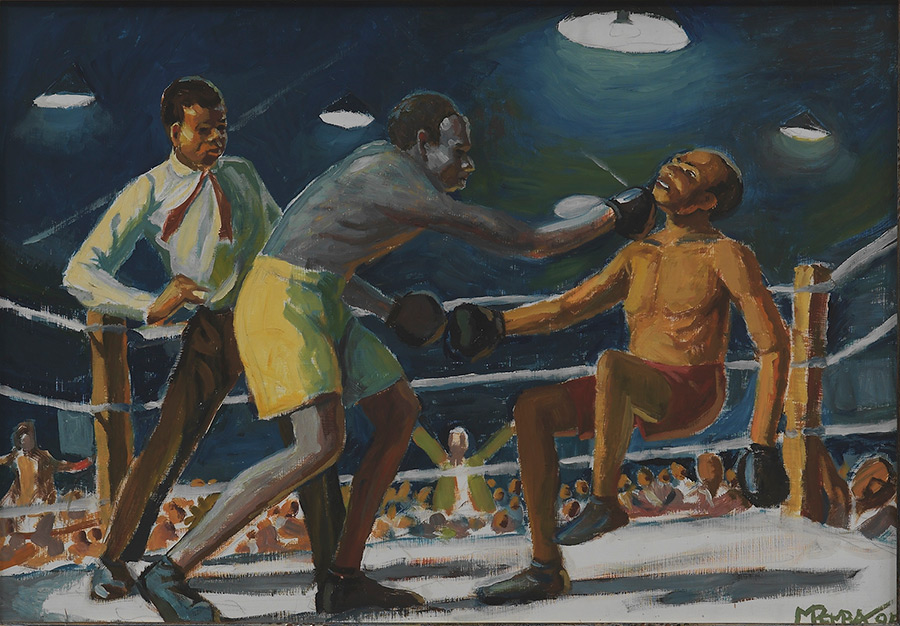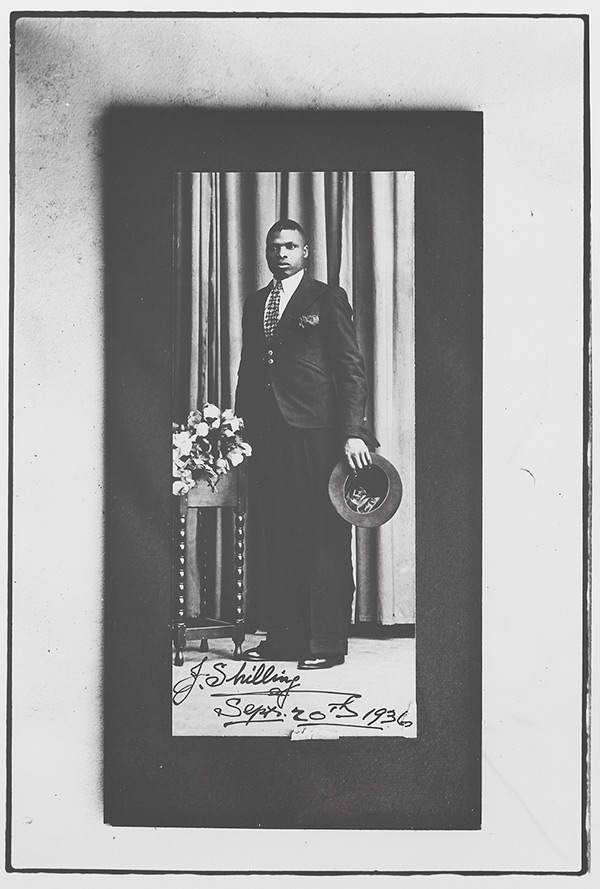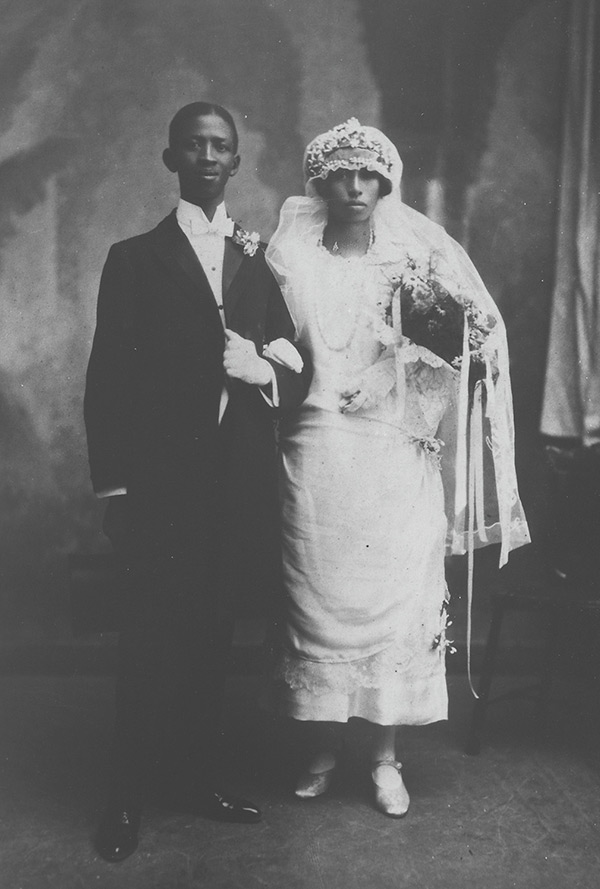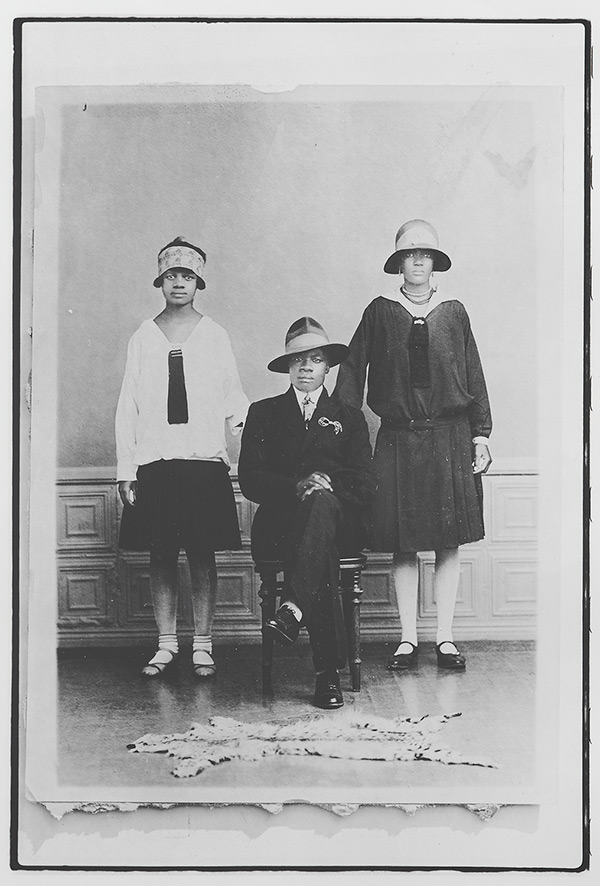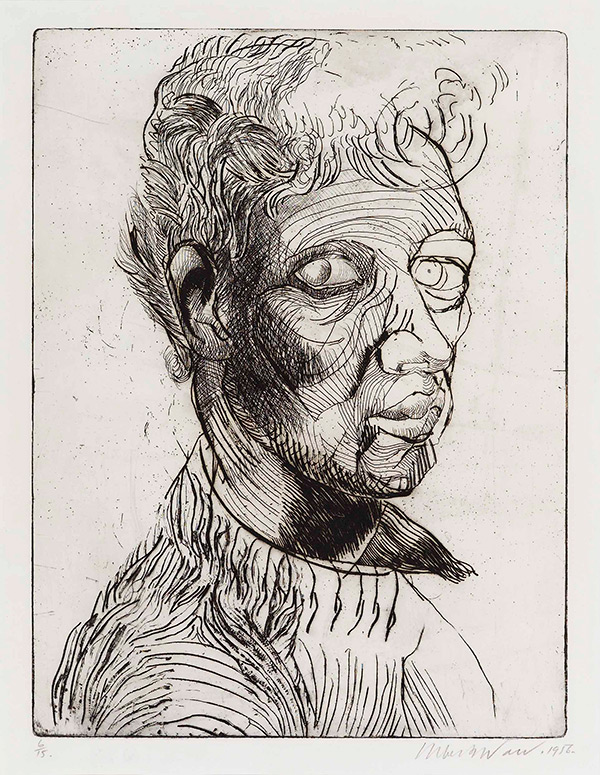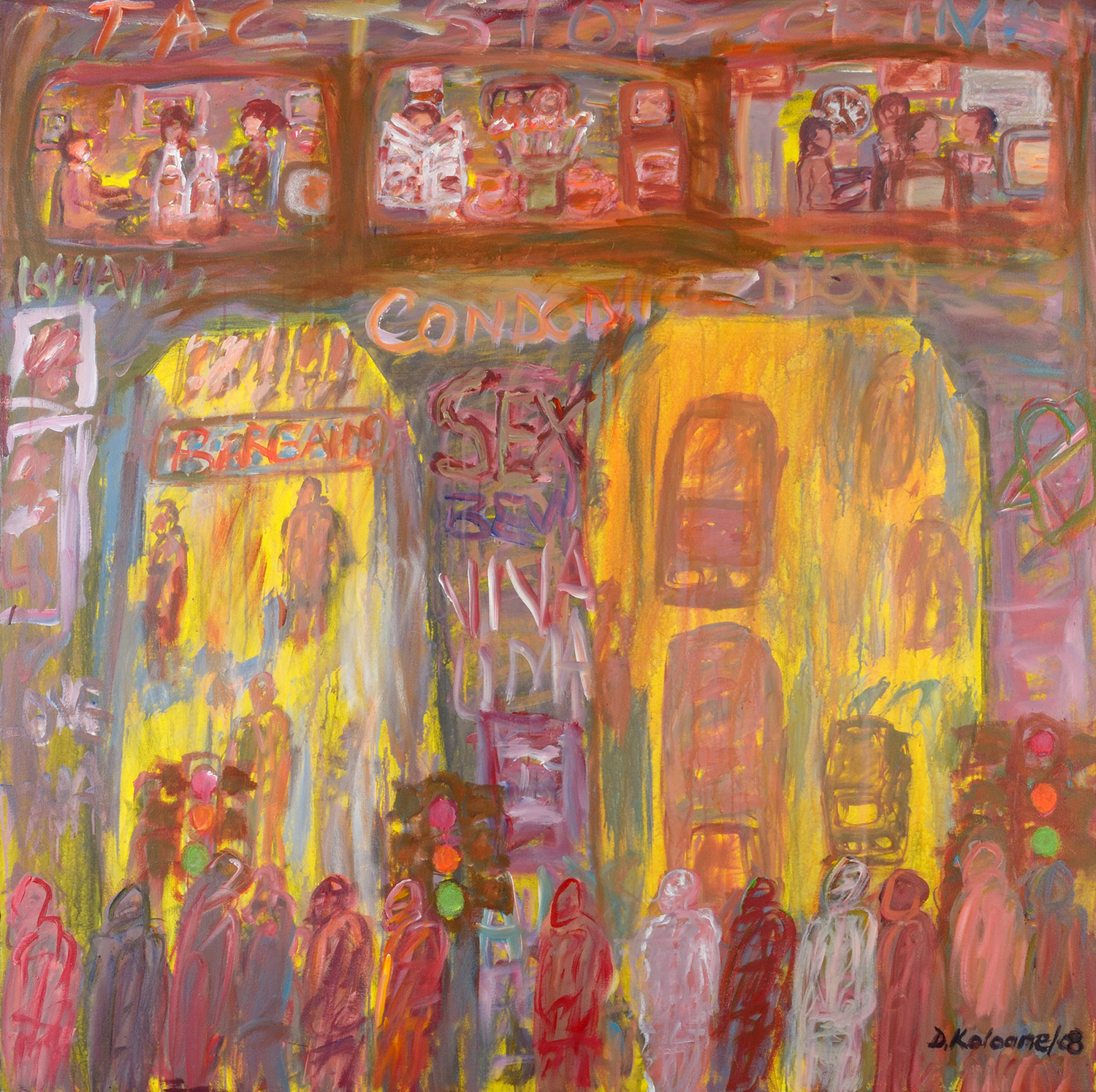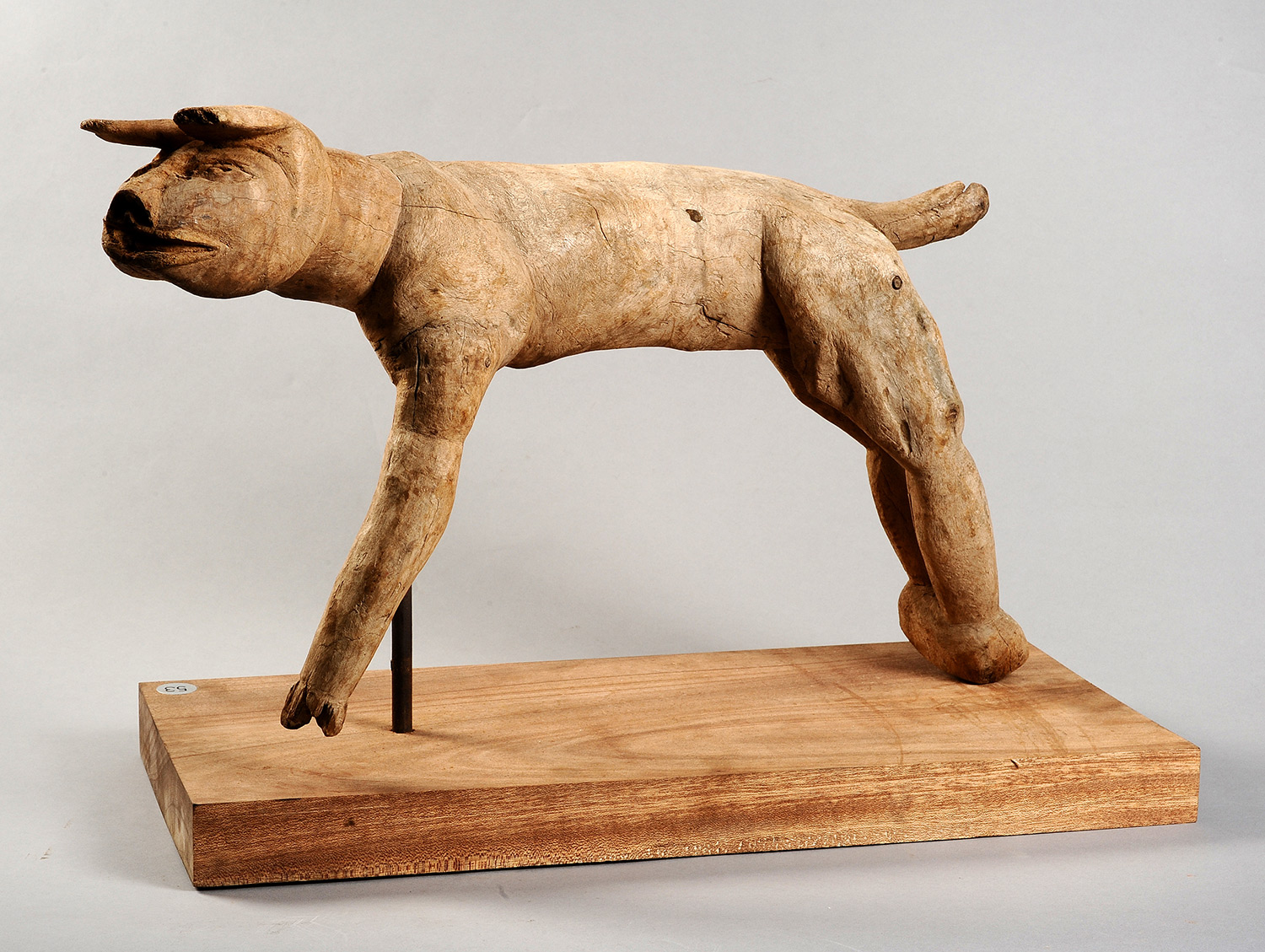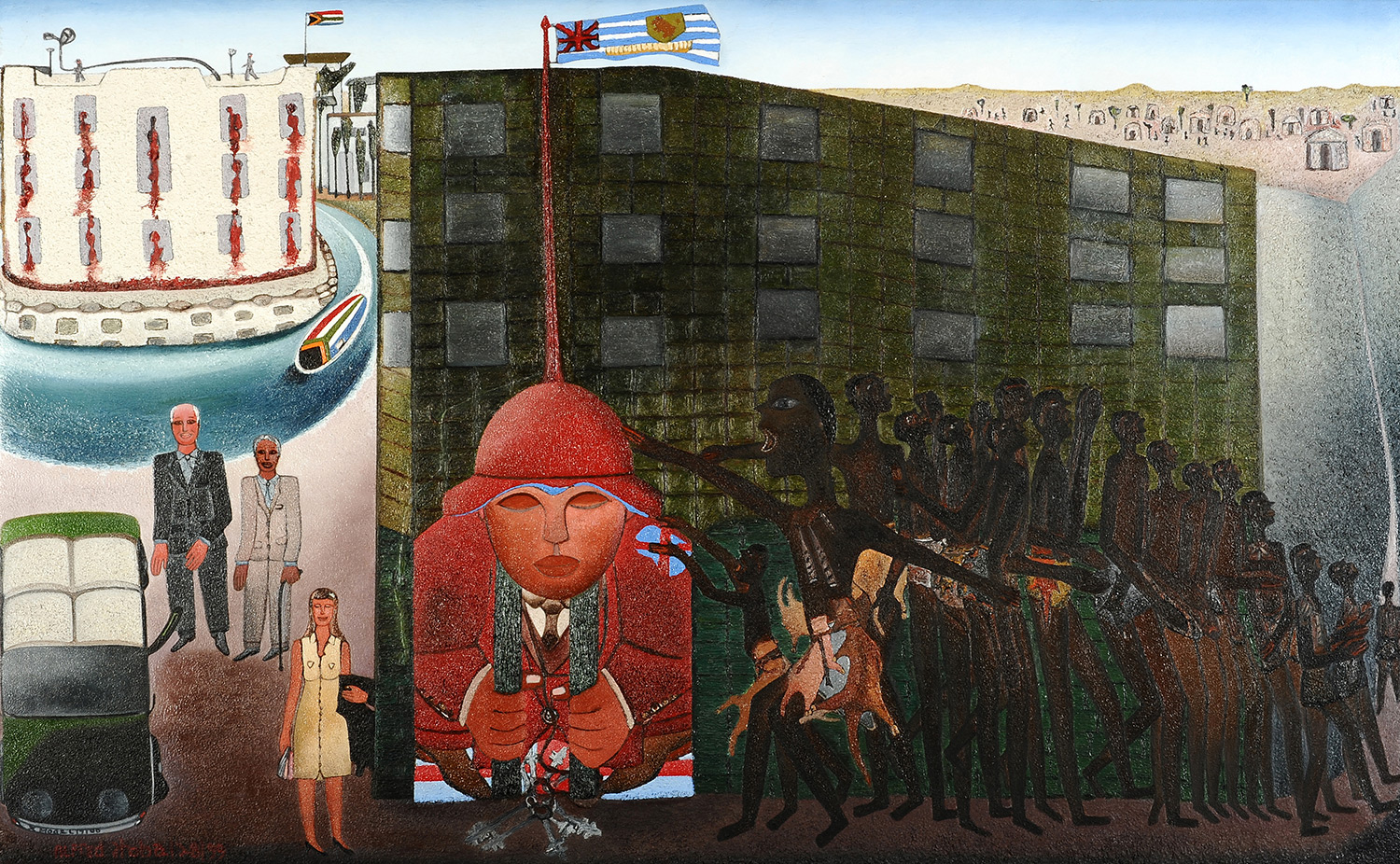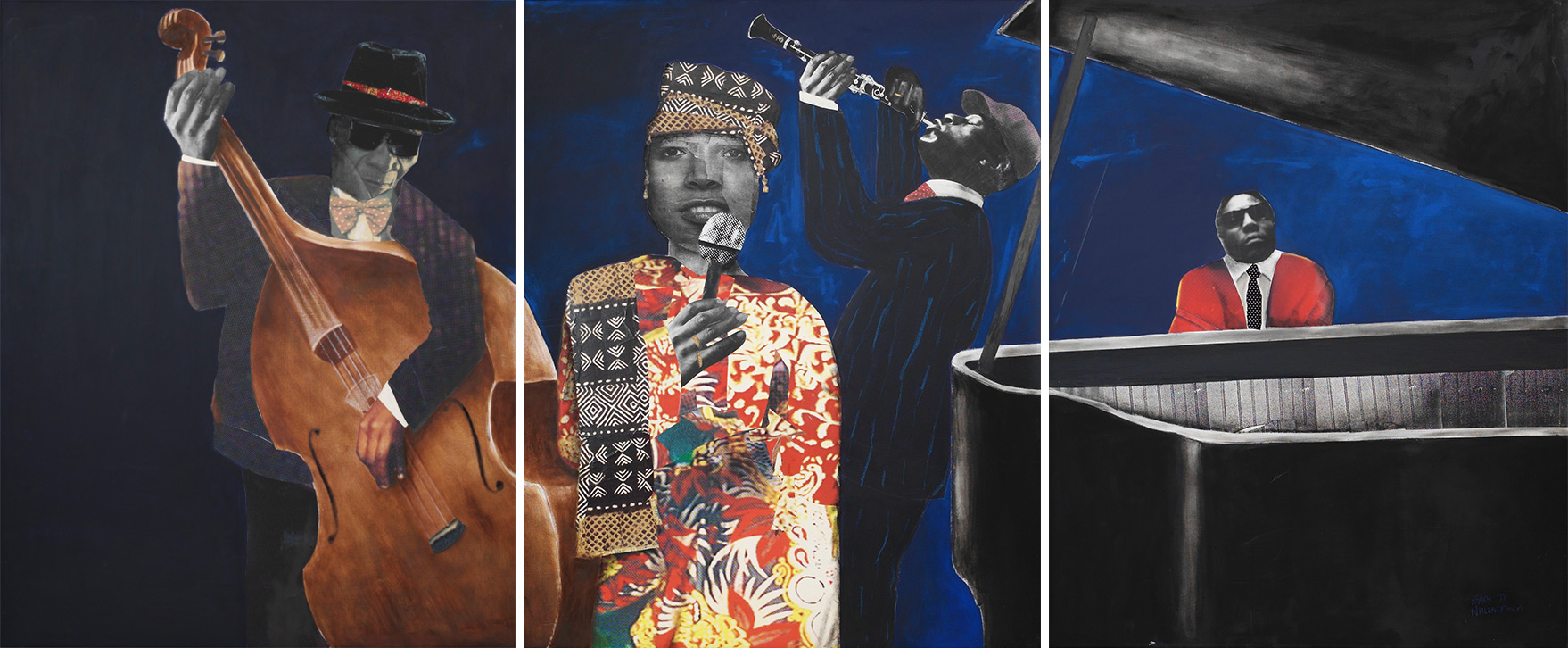Loans
The SABC Art Collection has an active loan schedule, frequently loaning artworks to institutions around the country and the world.
Works from the SABC Art Collection are requested for display as part of other curated shows at museums and galleries. Ongoing loans are part of our commitment to getting as many people as possible to see the artworks owned by the SABC and making the Collection as public as possible.
Yakhal’Inkomo
Javett Art Centre, University of Pretoria
26 March 2022 – 15 January 2023
Two works from the SABC Art Collection – Sam Nhlengethwa’s News Time (1977) and Julian Motau’s Emaciated Miner (1967) – were shown as part of Yakhal’Inkomo [‘the bellowing bull’], an exhibition which showed at the Javett Art Centre at the University of Pretoria from until 26 March 2022 to 15 January 2023. Both artworks tied directly into the curatorial theme of the exhibition.
The exhibition’s title, Yakhal’ Inkomo, is drawn from a 1968 jazz anthem by the saxophonist and jazz composer Winston Mankunku Ngozi. It refers to the fundamental role of the bull in African life, symbolising spiritual passage, awakening and resilience, as well as material wealth, strength, collectivity and community. ‘Ngozi’s anthem delves into the Black psyche and conjures up feelings of deep remorse, anguish and anger. But it is also a testament to the strength and resilience of creativity in the face of grief and dispossession,’ reads the exhibition statement.
Yakhal’Inkomo was guest curated by Tumelo Mosaka with Sipho Mndanda as Co-Curator and Phumzile Twala as Research and Education Coordinator.
Julian Motau (1948 – 1968)
Emaciated Miner
1967
charcoal on paper
100 x 75 cm
Drawn primarily from the Bongi Dhlomo Collection, the artworks included in the exhibition explored the complexity of the Black experience of urbanisation, estrangement, displacement, spirituality, as well as the texture of ordinary life. They conveyed seminal moments in the history of people’s defiance of state oppression under Apartheid.
Nhlengethwa’s News Time is a collage-on-paper work that vividly depicts a familiar scene from urban South African street life — a dapperly dressed man in a cap, suit and tie takes in the dreaded daily news from a broadsheet newspaper, while two others while away some time on the opposite side of a public bench facing a barren brick wall, and a pedestrian passes by. Nhlengethwa’s characteristic, tongue-in-cheek humour can be felt in the fact that the work has been partially pieced together with newsprint, so the newspapers in the image are made up of the very material they represent. This early work by Nhlengethwa evidences his initiating explorations in the medium of collage for which he is now widely acclaimed.
The Motau drawing Emaciated Miner is a much more sombre work. This visceral charcoal drawing depicts a near-naked man. Rendered with nervy lines of black charcoal, his body appears to have been reduced to sinew and bone by hard labour on the mines. He holds one hand to his head in exasperation and the other to his groin in a fundamental gesture of self-protection. In the background, we see the corner of a shack, the full moon and a street pole, which could be read as a Christian cross – only very ironically though, as there appears to be no salvation or mercy here. You can almost hear the wail of the bull emanating from this painful, expressionist work by Motau.
‘The exhibition Yakhal’Inkomo and its program explore how Black South African visual artists, musicians, poets, theatre makers, filmmakers and writers forged acts of creative defiance during the most tumultuous times under apartheid (1960s to late 1990s),’ reads the curatorial statement. ‘Working across media, artists not only recorded their pain and trauma, they redefined and celebrated their identity against the cultural imposition of the state. While the voices and actions of many of these artists were limited by censorship and suppression, their contributions were instrumental in keeping Black culture alive and resilient during the struggle years.’
The SABC Art Collection welcomed this collaboration with the Javett-UP, a partnership between the University of Pretoria and the Javett Foundation. Javett-UP is a multidisciplinary space that encourages engagement with the ideas, methodologies and concerns in relation to the art of Africa. Its public programme includes a variety of arts, from dance to music, poetry and fine art. It also hosts film screenings, lectures, talks and seminars in a state-of-the-art, 120-seater auditorium.
Javett-UP is housed in a building on the south campus, connecting the university with the city of Tshwane via a bridge over Lynnwood Road. Aside from temporary exhibitions, the Art Centre houses several permanent collections including a collection of 20th century South African art, the AngloGold Ashanti Collection and the Mapungubwe Gold, an archaeological collection which is historically and culturally important for South Africa, the southern African region and the world.
Irma Stern: The Zanzibari Years
Norval Foundation
3 November 2021 – 1 August 2022
Irma Stern (1894 – 1966)
Seated Arab Man
1945
oil on board
70 x 70 cm
The SABC Art Collection loaned Seated Arab Man (1945), a portrait in oil paint on canvas by Irma Stern, to Norval Foundation for inclusion in the exhibition Irma Stern: The Zanzibari Years, curated by Karel Nel.
This exhibition focused on a small body of significant works produced by Stern during her two stays in Zanzibar and the period surrounding 1939–1945. This exhibition marked the first time in nearly 40 years that a body of these Zanzibari works, considered among her finest, were exhibited together.
Stern travelled frequently between South Africa and Germany as a child and this pattern continued into her adult life. During the 1920s, ’30s and ’40s, she exhibited throughout Europe and was both known and respected there – more so than in South Africa, where the reception of her work was overwhelmingly negative.
Unable to return to Germany yet uncomfortable in South Africa, she spent time in remote parts of the country and undertook a number of intrepid journeys to Senegal, the Congo and Zanzibar, an island which she had visited briefly as a child in 1904 during a voyage to Europe.
The paintings from her time in Zanzibar consist primarily of portraits of Arab imams and men at prayer or in groups at the mosque but also include portraits of fathers and sons, sheiks, merchants and fishermen, as well as a striking series of Zanzibari women from Arabic, Indian, Bohari and Swahili communities. These women have been portrayed dancing at marriage celebrations, in quietly meditative states or engaging directly with Stern as a painter.
A number of sumptuous still lives also date from this period, as well as a handful of paintings of Arabic architecture and private walled gardens.
The body of work is hallmarked by a series of powerful portraits with an immediacy that reflects the mutually focused engagement between Stern and her sitters. Her mark-making evokes, at times, the sweep and syncopation of Islamic calligraphy, which she encountered in the carved cartouches of the lintels of Zanzibari doors and the Islamic manuscripts that she collected. The boldness of her impasto brushwork results in a tangible embodiment of her sitters and their contexts, such that her decision to frame the works using fragments of Zanzibari doors feels completely in keeping.
The distinctive frames, made of lintels, bosses and decorative door edgings, read as windows or architectural framing devices that evoke a spirit of place. Stern returned with a number artefacts, some of which were reproduced in the partly-handmade book, Zanzibar, published by JL van Schaik in 1948. Some of these fragments that Stern brought back, as well as a complete Zanzibari door, form part of the exhibition, enabling an appreciation and analysis of the symbolic structure of the Islamic door and the pattern-language integral to this carving tradition.
This period of Stern’s work, frequently regarded as a high point of her painterly career, was the exclusive focus of the exhibition which was – in its presentation – profoundly influenced by her book, Zanzibar. The book informed not only the choice of works to be presented but also the selection of objects that provided the viewer with a glimpse into the island world in which Stern lived and worked. This exhibition thus allows viewers to imagine with empathy the context that gave rise to some of Stern’s most distinctive works. – adapted from a text published by Norval Foundation.
George Pemba and Robert Hodgins: Social Stances
Strauss & Co Gallery, Houghton, Johannesburg
1 – 30 July 2021
Visionary Artists, Parallel Lives: Gladys Mgudlandlu and Maggie Laubser
Strauss & Co, Turbine Art Fair (online during COVID-19 lockdown)
27 August – 2 September 2020
The SABC has participated in two of the four Strauss & Co legacy shows, loaning works by Maggie Laubser, Gladys Mgudlandlu, Robert Hodgins and George Pemba.
This well-received series of Strauss & Co legacy exhibitions, launched in 2019, pairs prominent South African artists (Louis Maqhubela and Douglas Portway, Maggie Laubser and Gladys Mgudlandlu, Robert Hodgins and George Pemba, Mary Sibande and Dorothy Kay).
‘These shows were seminal,’ says curator Koulla Xinisteris. ‘The singularity of showcasing artists in this way contributes enormously to lost legacies. The SABC Art Collection has focused on filling in these gaps by acquiring strong and representative artworks and, as a result, has participated in local and international exhibitions.’
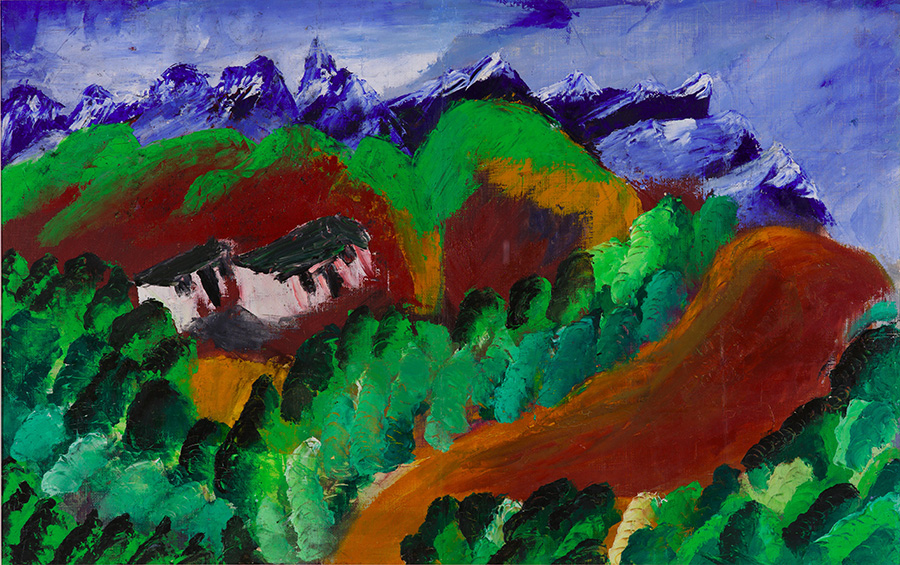
Gladys Nomfanekiso Mgudlandlu (1917 – 1979)
Landscape
gouche on board
40 x 64cm
The first of these exhibitions was Visionary Artists, Parallel Lives, which surveyed the work of Gladys Mgudlandlu and Maggie Laubser, two very similar yet also distinct painters.
Both Mgudlandlu and Laubser grew up in rural settings, in the Eastern and Western Cape respectively, and both experienced a very religious upbringing. Both artists’ families and wider communities derided their artistic inclinations and the early works and exhibitions of both were heavily criticised. Mgudlandlu’s works were considered too innocent, naïve, and even escapist, while Laubser’s paintings were deemed too modern, initially, and later, not modern enough
‘The phenomenal legacy of these two artists is indisputable,’ says Wilhelm van Rensburg. ‘Laubser’s work has been the subject of many academic studies and boasts the only comprehensive catalogue raisonné published to date on the work of a South African artist. Mgudlandlu’s work is especially important as she was the pioneer Black woman artist in the mainstream art world, and she serves as continuous creative inspiration for a number of contemporary practitioners, including artist Kemang Wa Lehulere, architect Ilze Wolff and curator Nontobeko Ntombela.’
George Pemba (1912 – 2001)
Boxers in the Ring
1985
acrylic on board
52 x 75cm
The second Strauss & Co legacy exhibition for which the SABC Art Collection loaned art works was George Pemba and Robert Hodgins: Social Stances. Pemba and Hodgins took up very different stances towards their society, the main source of inspiration for their art: Pemba, with a very humane attitude towards society, depicted traditional African culture and his own local contemporary way of life, and Hodgins, a more satirical stance towards Western society, portraying an urban way of life, shot through with an array of humorous and literary references.
Both Pemba and Hodgins grew up in rural settings before moving to big cities, Pemba in the Eastern Cape and later Port Elizabeth, and Hodgins with foster families in rural England, and later London (he first visited South Africa in 1938, and then moved permanently in 1953). Not only did Pemba depict African life in rural areas with its myths and legends and traditional cultural practices, but he also painted many scenes of the urban life of ordinary people, caught up in the socio-political situation of his time, with sympathy and pathos. – adapted from Strauss & Co exhibition statements
101 Collecting Conversations: Signature Works of a Century
Javett Art Centre, University of Pretoria
24 September – 31 December 2020
In 2020, the SABC Art Collection loaned several works to the nascent Javett Art Centre at the University of Pretoria for inclusion in its opening exhibition, 101 Collecting Conversations: Signature Works of a Century.
‘Public and private collections stem from a variety of catalytic impulses and are assembled and generally held in trust to educate, enchant and amaze. They are also representative of the time and period in which they are collected and historically significant in their manner of collection. They contain a wealth of material and information to explore and interpret particularly from a post-colonial and contemporary perspective,’ reads the exhibition statement.
The Javett-UP brought together examples of artworks drawn from such collections across the country and further afield selected in conversation with the curators and owners. These included works of historical importance in that they have played a formative role in an artistic movement, context or era.
Images tend to grow in stature as time passes by and the time span from which the artworks represented on the exhibition were drawn was between 1920 and 2020.
Santu Mofokeng (1956 – 2020), Black Photo Album/Look At Me, 1890–1950, 1998 [originally produced as a slide projection for the Johannesburg Biennale in 1997], set of three black and white photographs on Baryta paper, 38 x 27cm
The works loaned from the SABC Art Collection were: George Pemba’s Boxers in the Ring (1995); Cyprian Mpho Shilakoe’s Stop Crying Mother, He May Come (1969); David Koloane’s Smoky Cityscape II (2008); Guy Tillim’s Mai Mai militia in training near Beni, eastern DRC for immediate deployment with the APC (Armee Populaire du Congo) the army of the RCD-KIS-ML, Portrait VI (2003); three archival photographs from Santu Mofokeng’s Black Photo Album/Look at Me: 1890–1950 (1998) [originally produced as a slide projection for the Johannesburg Biennale in 1997] and David Goldblatt’s Cells (1999).
The curators articulated the selection criteria for the exhibition as follows: ‘Works which symbolise the artistic movement from which they arise, works which they tell us something about the times in which they were created. Works which represent a stylistic imperative, demonstrating a unique art style and/ or excellent/master technical skill of the medium. Works which have a resonance/message and/or subject matter that made a significant contribution to research, knowledge and society’s perspective and impact on public opinion – a general broad influence. Work with an enigmatic story – interesting back story of the work, artists background or history of the artists journey.’
The themes that were identified from the works were: politics, religious, cultural and traditional values, urbanisation and landscape and identity.
The aim of this opening exhibition was to launch the Javett-UP’s objectives to demystify the gallery and museum experience and to affirm the new art space as a place of education, collaboration and contemplation, a space where the Art of Africa is explored and celebrated.
Albert Adams: An Invincible Spirit
WAM (in association with SMAC Gallery and Edward Glennon, Adams’s life partner)
2 April – 25 May 2019
In 2019, Wits Art Museum celebrated the 90th anniversary of the birth of Johannesburg-born artist Albert Adams (1929–2006) with a retrospective exhibition curated by Marilyn Martin. The SABC Art Collection loaned two works by Adams for inclusion in this exhibition that included drawings, paintings and prints spanning his 50-year career: Self Portrait (1956) and Pieta (1948).
A mixed-race person during the Apartheid era, Adams was refused entry to Michaelis School of Fine Art at UCT, but went on to study at the Slade School of Art in London, the University of Munich, under Oskar Kokoschka and lecture in Art History at City University, London for 18 years. Although he left South Africa in 1960, he visited frequently and consistently returned to the depiction of themes related to his country of birth. His paintings, drawings and prints reveal a visceral expressionism, deep social commitment and searing commentary. Subject matter includes powerful reflections on the outcasts of society, incarceration, the dark side of celebration and religious imagery.
Albert Adams (1929 – 2006)
Self Portrait
1956
etching
43.5 x 34 cm
David Koloane: Chronicles of a Resilient Visionary
WAM (Wits Art Museum)
19 November 2019 – 1 February 2020
This exhibition commemorated the iconic legacy of late renowned artist and social activist David Koloane. A mentor for many of South Africa’s contemporary artists, Koloane sought to create spaces for Black artists to flourish, such as the Bag Factory Artists’ Studios and Thupelo workshops.
The SABC Art Collection loaned the painting Under the Bridge II (2008) for inclusion in this exhibition.
The exhibition was curated by Dr Thembinkosi Goniwe, organised in collaboration with Goodman Gallery and included artworks from the WAM Collection and the artist’s personal archive.
Koloane’s experimental art explores the dynamic, disorderly and troubled histories of Johannesburg – its chaotic streets, high-rise buildings, slums and townships; its music violence, congestion, vendors and stray dogs – with a chromatic and expressive intensity that typifies the modernism of his generation, writes Athi Mongezeleli Joja in Artforum. ‘These cityscapes depict spatial and psychic derangements as vestiges of colonization.’
David Koloane (1938 – 2019)
Under the Bridge II
2008
acrylic on canvas
63 x 63 cm
Crossing Night / Hacer Noche
A large-scale exhibition initiative held in Oaxaca, Mexico
4 November 2018 – 5 February 2019
In 2018, the SABC Art Collection loaned Jackson Hlungwani’s wooden sculpture Dog to be exhibited as part of Crossing Night / Hacer Noche, a major exhibition project curated by Francisco Berzunza and staged across various venues in Oaxaca, Mexico.
Comprising five exhibitions, an artists’ residency programme, a community-based educational programme and a conference, Crossing Night/ Hacer Noche examined the historical links between southern Africa and Mexico through the lens of contemporary art.
The project delved into societal relationships to death and dying within the southern African and Mexican contexts: the relationship between violence and death, the ethics of how we relate to corpses, rituals of life, death and the afterlife, our connections with our ancestors.
Jackson Hlungwani (1923 – 2010)
Dog
1993
wood
43 x 60 x 24 cm
Serving as an entry point to a broader search for shared ways of relating to history in the present in these two postcolonial regions, Hacer Noche/ Crossing Night touched on the tender and finite nature of human existence, and how our will to make is ultimately a will to be remembered.
The project featured work by artists Tiago Borges, Steven Cohen, Marlene Dumas, Dumile Feni, Jared Ginsburg, David Goldblatt, Georgina Gratrix, Haroon Gunn Sallie, Dan Halter, Nicholas Hlobo, Jackson Hlungwani, Pieter Hugo, William Kentridge, David Koloane, Moshekwa Langa, Kemang Wa Lehulere, Ernest Mancoba, Sabelo Mlangeni, Santu Mofokeng, Samson Mudzunga, Zanele Muholi, Simphiwe Ndzube, Antonio Ole, Athi Patra-Ruga, Jo Ractliffe, Robin Rhode, Cinga Samson, Mmakgabo Helen Sebidi, Johannes Segogela, Penny Siopis, James Webb & Portia Zvavahera. – adapted from A4 Arts Foundation exhibition text
Alfred Thoba: A Step Becomes a Statement
WAM (Wits Art Museum)
14 March – 3 June 2018
This survey exhibition, curated by Julia Charlton, presented work by Alfred Thoba, a South African artist with a distinctive style and vision that has cemented his unique legacy. The SABC Art Collection loaned two works by Thoba for inclusion in the exhibition: The Woodcutter and His Family (1994) and Abolition of Slavery in South Africa (1999). The show spanned four decades and represented an in-depth and overdue look at a painter, whose work chronicles major milestones in South Africa’s political history and his own personal journey.
Alfred Thoba (1951 – 2022)
Abolition of Slavery in South Africa
oil on canvas
95 x 155cm (unframed)
106 x 166 cm (framed)
1999
Peter Schütz: An Eye on the World
WAM (Wits Art Museum)
9 June – 16 August 2015
The SABC Art Collection loaned several works to this exhibition, which focused on the extraordinary carved work of late sculptor Peter Schütz.
Using his most favoured medium of jelutong wood, Schütz created exceptionally fine carvings which explore themes of violence, myth, religion and spirituality. Madonnas, saints and religious artefacts depicting the female figure are iconic symbols that influenced his work.
The works by Schütz loaned for the exhibition were: St Cloud (2006); Potency Staff II (2007); The Initiate (2006); and St Lucy (1997).
Peter Schütz (1942 – 2008)
Budding Daphne
2002
jelutong and oil colour
80 x 27 x 20cm
Schütz said of his work: ‘I take pleasure in the physical side of sculpture and like to honour the old methods of craftsmanship with contemporary manipulations, allowing the work to evolve beyond the original concept.’
As a senior lecturer in the Wits Fine Art Department for close to 20 years, Schütz had a long association with Wits University. This exhibition was a focused reflection on the time he spent at Wits University and his deep and sustained interest in WAM’s extraordinary African art collection. References from traditional African artwork, particularly beadwork and Zulu cultural practices can be seen in many of his sculptures. Schütz’s work questions images of representation and identity across cultures making them very relevant to contemporary South African life.
Sam Nhlengethwa: Life, Jazz and Lots of Other Things
SCAD Museum of Art, Savannah, Georgia
18 February – 22 June 2014
Life, Jazz and Lots of Other Things was Sam Nhlengethwa’s first solo museum exhibition in the United States. The SABC loaned Nhlengethwa’s Midnight Blues (1999) for inclusion in this exhibition, curated by Laurie Ann Farrell, then SCAD’s executive director of exhibitions.
The show featured a broad cross-section of the artist’s practice and themes and opened with a juxtaposition of works by Nhlengethwa and Romare Bearden orienting viewers to a significant creative voice for the artist.
Sam Nhlengethwa (1955)
Midnight Blues
1999
triptych
oil and collage on canvas
150 x 360cm
It also featured vibrant jazz scenes, images of daily life and nation building, along with iconic works that touch on deep social issues.
‘Based in Johannesburg, Nhlengethwa is revered as one of South Africa’s leading contemporary artists. … Paintings, installation, works on paper and tapestries provide insight into Nhlengethwa’s worldview through the eclectic array of life, jazz and lots of other things,’ reads the exhibition statement.


